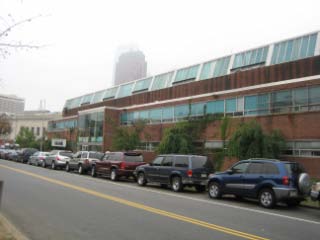The Barnes Foundation, according to its own website "is home to one of the world's largest collections of Impressionist, Post-Impressionist and early Modern paintings, with extensive holdings by Picasso, Matisse, Cézanne, Renoir and Modigliani, as well as important examples of African sculpture."
The design for the new home of the worldclass impressionist collection amassed by the uber-contentious Dr. Al Barnes bears an eerie and unwelcome resemblance to the Juvenile Detention Center which it replaces.
A Bit of Barnesian Background
The Barnes Collection has one of the most embattled legacies in the history of American art collection, even inspiring a movie with the overwrought title “The Art of the Steal." The good doctor who died in 1951, made a fortune in nostrums and patent medicines. He also had a true talent for shopping in Europe and managed to scoop up a lot of "bargain basement" art at firesale prices. I haven't seen "The Art of the Steal." I wonder if it even touches on how this shiny collector and creator of Argyrol, nickled the starving artists whose works he bought for a song. But that's art in the age of commerce for you--a sad tale, but scarcely worth a historical footnote.What makes the infamous Barnes backstory fascinating is that Doc B had no great love of the city and its business and cultural leaders. Seems they turned up their narrow blue noses at his self-made, new money social ascendancy, so he got his payback. Using his collection as a sort of cultural hostage, he forged a will he clearly intended to be unbreakable. Then he used it as a hammer to hit the art establishment over the head with, long after he was gone. Basically, the will said that The Collection could never:
- Be broken up
- Exhibited/toured
- Or worse, moved!
Maybe a hundred years hence, the Barnesiacs and the township of Merion will band together and take a page from the Egyptians who after decades of righteous contention, were able to repatriate their priceless antiquities from the Louvre. The fact is that languishing out in leafy Merion, PA, mired in restrictive visitation policies, the prickly half-love of its neighbors and the bizarre internecine politics of its dysfunctional board, the Foundation and its Collection was drowning in red ink. The Pew and the Lenfest Foundations stepped in and threw Barnes a lifeline, but the bailout inked a devil's deal. It required the collection to move to the city where it can finally be appreciated by Philadelphia residents and visitors without special papal dispensation.
This battle waged famously for years in Philadelphia Orphan's Court. Recently Barnes' grudge-drenched will was broken in a gust of sulfur and smoke and what I'm sure are several legal precedents. Philadelphia Lawyers may moan, but art lovers of all stripes are the beneficiaries. Albert Barnes' vitriol was ultimately his foundation's aqua regia. The experience of the Barnes an object lesson in how even great philanthropy can run aground when a benefactor's nits and gripes overshadow a more expansive, enduring vision of contribution to society. Anger, art and philanthropy make for a gritty salad.
I'm just a little guy with a big mouth and I doubt I'll ever be able to put the following principle to the test. But I believe that if you have the resources to acquire great art, it comes with an implicit noblesse oblige to share your spoils with society. What Barnes did was like commissioning a Mozart symphony, then restricting its performance to his basement. Great art demands the greatest possible audience--access by ordinary people who would be its patrons. Not an elite few. However much money and power you have, you can't narrowcast a cultural legacy in perpetuity. That's the nutshell. Now back to the future.
The House that Barnes Didn't Build
Call it "the takeover of the imperial art establishment" or just call it inevitable triumph of good sense; it seems in any case to be a done deal, a baked cookie. What feels half-baked, is the design by Todd Williams and Billie Tsien. Look at their spectacular design for the Phoenix Art Museum then come back and compare. Though in an Inquirer online reader feedback poll people seem to prefer the new design by a large margin, I ask:
'Where is the visual drama worthy of the collection?'
Why must so much Philadelphia architecture be confined to pedestrian brick and stone? Why don't the commissions who rubber stamp blandchitecture like this have the cojones to point the fancy out-of-town architects back to their drawing boards with the stern admonition to really "bring it" next time. Don't the architects who design for this city have more contemporary and uplifting materials in their palettes? In the case of Williams and Tsien, they do, they just ain't sharin' it with Philly. Everywhere I go in Philly, I see new buildings going up that look like more of the same. They think they're reflecting the spirit of the city, when in my humble, each new uninspired brick and stonefaced edifice reinforces an anti-progressive, provincial frumpiness this city is trying so hard to shake off.
 It's not that I'm looking for wild radicalism like Frank Gehry's scary metal monster in Bilbao, though love it, hate it, or think it resembles a Transformer, at least it makes a impression. Inga Saffron, whose every opinion I normally dote on like a starry-eyed fanboy, praised the punched windows resembling those in the facade of the Barnes' neoclassical home in Merion.
It's not that I'm looking for wild radicalism like Frank Gehry's scary metal monster in Bilbao, though love it, hate it, or think it resembles a Transformer, at least it makes a impression. Inga Saffron, whose every opinion I normally dote on like a starry-eyed fanboy, praised the punched windows resembling those in the facade of the Barnes' neoclassical home in Merion.Yawn. So what? A handful of punched windows aren't going to mollify the Barnesiacs who'd rather see their precious collection shuttered than exhibited the way worldclass art should be.
What is the virtue of such nostalgic tribute when weighed in the balance with an opportunity to create a bold, visual exclamation point to Philadelphia's aspirations to evolve as a center of art and culture? We deserve better.
Don't get me wrong, I am gladdened that this historic collection is finally about to be wrested out of its snuggery in the Land of Lockjaw, but it should come downtown and present its face to the Parkway. It should announce itself with drama and pride, not landscaping.
I walk The Parkway nearly every day. This corridor, one of my favorites in a gloriously walkable city, has so much potential. Yet I fear it will never be as grand as it could be, especially if one of its anchor tenants turns its face away.
"It is an absolutely masterful design. Those who don't understand the design are looking at it from a selfish point of view," according to Moe Brooker of the Philadelphia Art Commission.
I'm just a selfish guy. Well harumph!
I think not.
Maybe there's another movie in it
Call it, "The Revenge of Dr. Barnes."
Too bad Vincent Price isn't around to play the lead.




